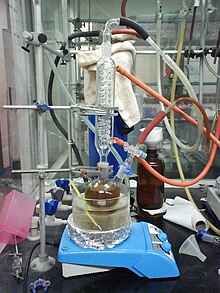Ketyl radical
In organic chemistry , ketyl radicals - also ketyls or metal ketyls - are radical anions that are derived from ketones and occur in several mesomeric boundary structures:
Ketyls are not very stable and usually occur as very reactive intermediate compounds. They are formed by single-electron transfer (SET = single electron transfer) of alkali metals on carbonyl groups . For example, the reduction of benzophenone by sodium to the intensely blue-colored ketyl in solvents is used to prove that they are absolutely anhydrous.
Ketyls are intermediates in the pinacol coupling , the acyloin condensation and the McMurry reaction .
In the laboratory, the ketyl radical of benzophenone is used as an indicator for the absoluteization of solvents with sodium. The absence of water and oxygen is indicated by the deep blue color of the mesomerism-stabilized ketyl radical.
In practice, the solvent to be absolute, e.g. B. toluene , under a protective gas with elemental sodium and a small amount of benzophenone as long (hours to days) heated under reflux until the blue color becomes clear. Since the sodium added in excess reacts with the water (possibly) contained in the solvent to form sodium hydroxide and with the oxygen to form sodium (per) oxide, an electron is transferred from the sodium to the benzophenone and the colored ketyl radical is formed. Under certain circumstances and depending on the type of further contamination, the solution does not necessarily have to have a blue color in the absolute state, since other colors can also come about due to side reactions.
Solvents absolute in this way are called "ketylated" and the device structure shown on the right is called "ketyls". In many laboratories there are specially equipped rooms or individual fume cupboards in which ketylene is in continuous operation in order to have constant absolute solvents available and, by avoiding the constant dismantling and rebuilding of entire equipment, to prevent the cleaning process from being extended or prolonged by humidity solvent that has already been absolute takes up water and oxygen again.
Web links
- Radicals in Organic Synthesis ( Memento from February 23, 2005 in the Internet Archive )
Individual evidence
- ↑ Otto-Albrecht Neumüller (Ed.): Römpps Chemie-Lexikon. Volume 3: H-L. 8th revised and expanded edition. Franckh'sche Verlagshandlung, Stuttgart 1983, ISBN 3-440-04513-7 , p. 2104.



